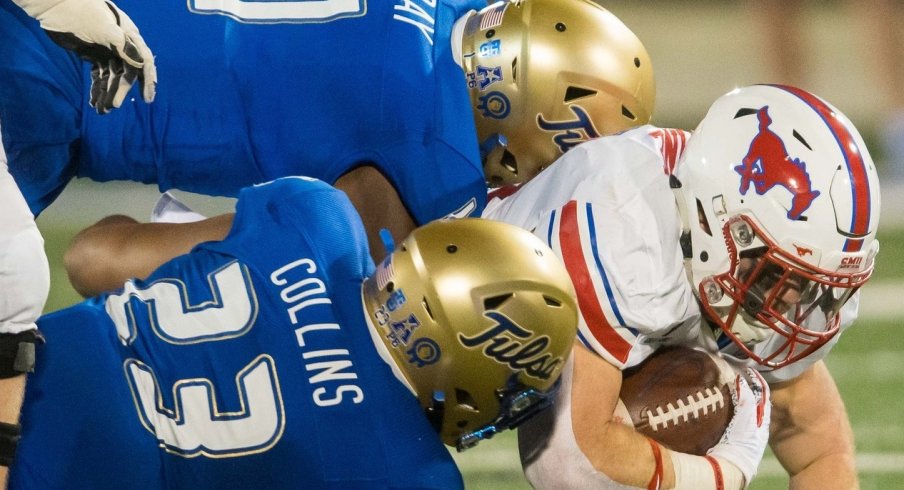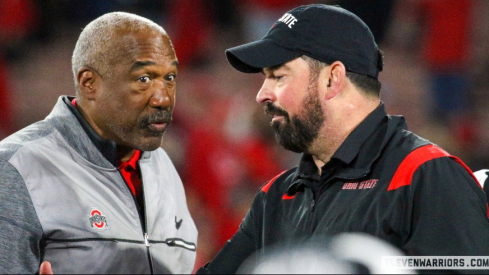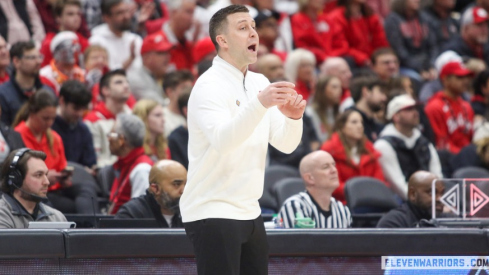You might not have realized Tulsa is on the schedule this fall, but Ohio State's offensive staff certainly has.
Despite playing in one of the nation's most explosive offensive leagues, the American Athletic Conference, the Golden Hurricane featured one of the nation's best defenses in 2020. While the most ardent fans of the sport may recall that the unit featured the Nagurski, Bednarek, and Lombardi award winner in linebacker Zaven Collins, the Tulsa defense finished 7th nationally in yards allowed-per-play and 19th in yards allowed-per-game thanks to the efforts of many.
Led by third-year defensive coordinator Joseph Gillespie, a head coach at the high school level until just 2015, the Golden Hurricane runs a system quite different from the one fans are used to seeing in Ohio Stadium. While Ohio State has long run some version of a 4-3 defense that looks to primarily stop the run by filling every single gap up front, Tulsa employs a unique, 3-3-5 system that takes a very different approach.
Derived from the old school, 3-4 defenses of the 1980s and 90s, Gillespie's system has evolved to meet the challenges of the modern game. As offenses evolved from 2-back sets to spread looks that put alley defenders like an outside linebacker in conflict through run-pass options (RPOs), many defenses responded by replacing such players with smaller, more athletic defenders like safeties and cornerbacks.
No matter how athletic that player may be, the offense can still make him wrong, no matter what, by simply reading him in the option game.
Tulsa, however, does not like to let the offense dictate its movements, choosing instead to force the opponent to take the path that can do the least damage. Knowing that throwing the ball is mathematically more effective than running the ball in today's game, Tulsa plays with five defensive backs spread out wide, signaling to the opposing quarterback that handing the ball off is the right decision on nearly every play.
By lining up with so many players outside of the box, the Tulsa defense is 'a gap short' by many coaches' arithmetic, meaning they don't have enough bodies to fill every hole between the blockers on a run play. But this is very much by design.
Without a Chase Young or Bosa brother to beat his opponent in the trenches and make a play in the backfield, the Golden Hurricane instead likes to clog the middle with a number of big bodies and funnel the ball outside. Instead of using an All-World edge defender to funnel the ball back toward the middle, like the Buckeyes often do, Tulsa's philosophy is known within the sport as 'spill and kill.'
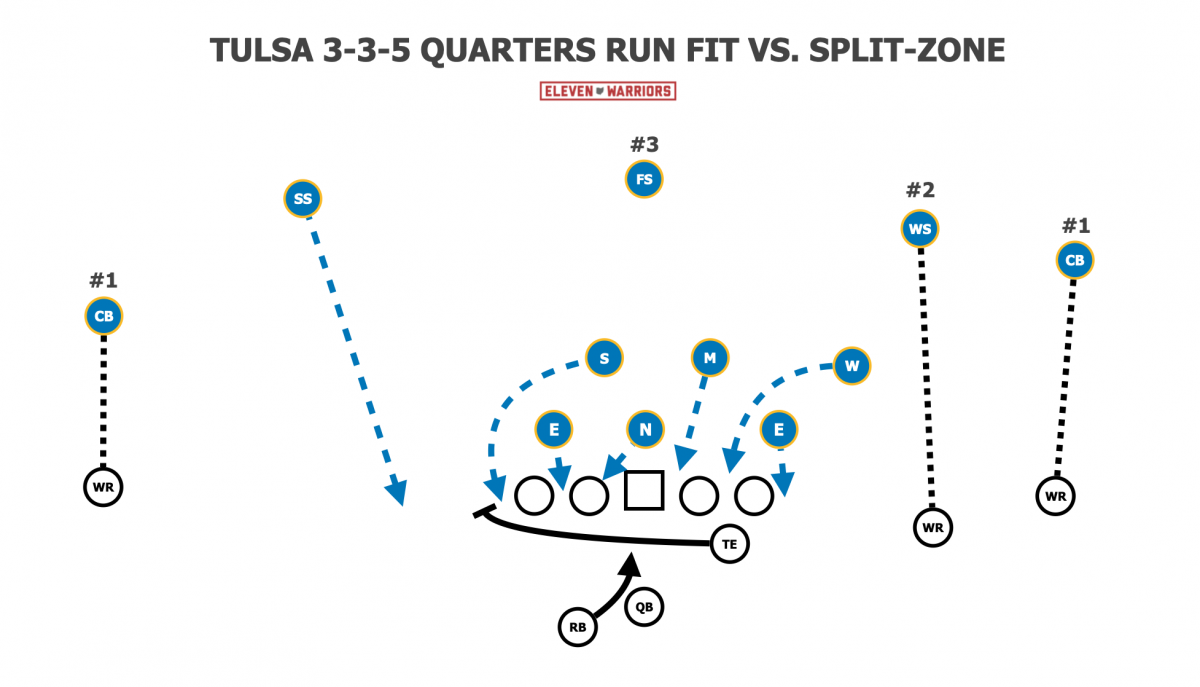
As good as Collins was, tallying four 11.5 tackles-for-loss, four sacks, and four interceptions last fall, sophomore safety Kendarin Ray actually led the team in tackles. At 6'4" and 200 lbs, the rangy DB was more than happy to clean up when runners were forced away from the middle.
Playing with three safeties, the Tulsa defense asks Ray to fill those gaps and come up to make plays once the ball is 'spilled' outside. Though often lining up 10-12 yards off the ball, he triggers quickly downhill once he reads run.
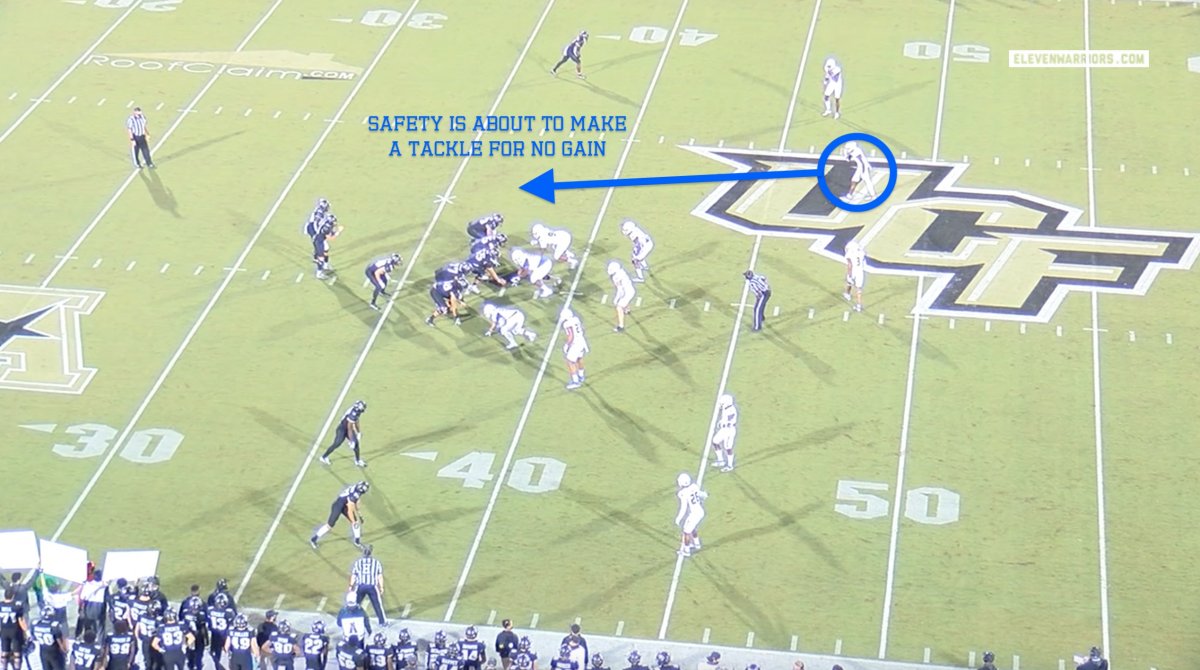
Though he is in a position to defend the pass downfield, Ray is watching the left tackle to get his read. As the blocker steps down to block the defensive end inside, Ray knows it's going to be a run play, and quickly flies up to make the tackle at the line.
But this isn't just due to Ray's quickness and tackling ability, as the rest of the Tulsa defense is working to bring the ball his way.
The down linemen are a pair of 300 lb behemoths whose job is to occupy as many blockers as possible without giving up ground, keeping the offensive line from executing the combination blocks that are so critical to zone-blocking schemes (like Ohio State runs so often). Not only does this keep the linebackers free, but it also forces the running back to bounce the ball toward the edge.
The split-zone scheme, in which an off-ball tight end comes across the formation to kick out the edge defender and create a cutback lane, is meant to take advantage of this defensive philosophy, but Gillespie's team is well-prepared for such tactics.
Though there is no defensive end on that edge, the SAM linebacker steps up to fill that role. As the pulling tight end engages, the SAM doesn't try to hold the edge but instead attacks the inside shoulder of the blocker to get across him and plug the cutback lane.
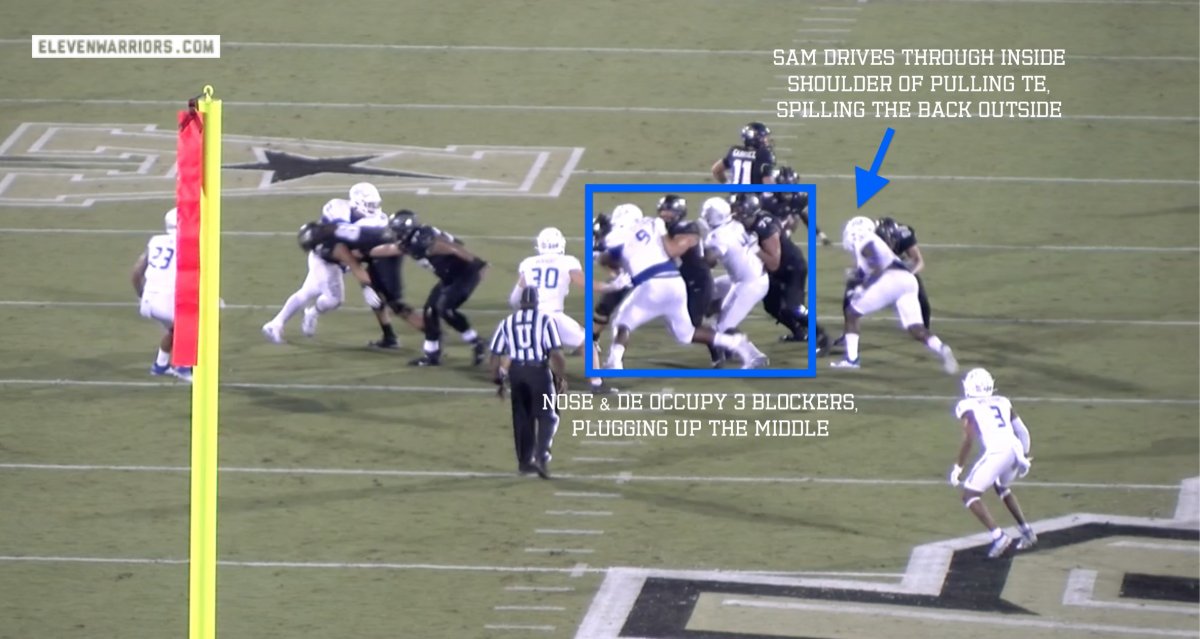
If executed effectively, the runner will be forced to bounce even further outside and into the waiting arms of the unblocked safety, Ray.
This philosophy has become more common across college and pro football, with teams like Dave Aranda's 2019 LSU defense and the 2020 Los Angeles Rams running what's known as the 'Tite' front. These units flummoxed opposing run games by taking away the middle, thanks to a nose tackle over the center and two ends in either B-gap, with a plethora of athletes capable of filling the edges in the secondary.
Even Alabama's record-setting offense had some trouble getting things going last year against Arkansas, as the Hogs plugged the middle with their three-man front and dropped eight behind it.
Tulsa's system diverges slightly from those teams, as it often only plugs one B-gap, playing a traditional defensive end on the front side but leaving a 'soft edge' on the backside to be filled by the safety (Ray).
When opponents do drop back to pass, Tulsa has plenty of options with eight defenders dropping in coverage. The Golden Hurricane showed a plethora of different coverages, showing everything from Cover 1 (Man-free) to Cover 3-Match to a variety of Cover 4 (Quarters) adjustments to even some old-school, Tampa-2 looks - all in the same game.
That Tampa-2 look, specifically, provides a nice change-up when teams begin to target Ray in their blocking schemes by using a receiver to seal him inside. Instead of asking him to fill that edge as the ball is spilled outside, Ray switches responsibilities with the corners, taking the outside receiver in a deep-half zone while the corner steps up to make tackles.
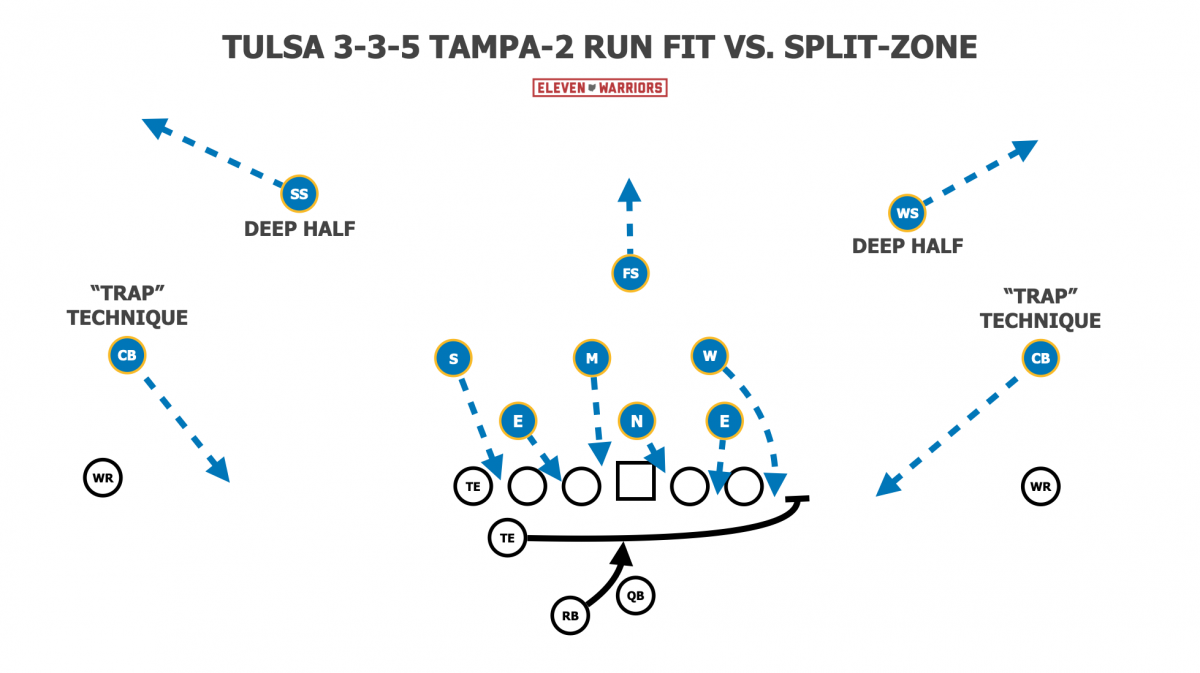
This technique, known as a 'trap' by the corners (or "sight" in Don Brown's defense), is most effective when the offense lines up a single receiver, which is quite common when there are two tight ends in the game. As seen here against the nation's 2nd-best offense last season, UCF, the Tulsa defense had no problems stopping the run game despite being outnumbered 7-6 in the box before the snap.
This approach does come with some risks, however. While it's meant to disrupt the zone run games so often favored at the college level today, it can be exposed by well-executed gap schemes.
For instance, Tulsa held former 2,000-yard rusher Chuba Hubbard of Oklahoma State to 3.44 yards-per-carry in last year's season opener, stifling the Cowboys' outside zone scheme. But he was able to find some room to run behind a GT-Counter play that didn't look for double-teams up front, and instead pulled the backside guard and tackle around to block second-level defenders.
Additionally, this is still a Group of Five program, after all. Despite how good players like Collins and Ray may be, not everyone in the unit can be protected from getting exposed in one-on-one matchups against superior competition.
With the secondary looking to take away passes in the RPO game, and forcing the offense to hand the ball off whenever possible, the backside cornerback can often be left on an island on early downs. Against good QBs, like UCF's Dillon Gabriel, that's a mismatch just waiting to be exploited for a big gain downfield (as seen at the bottom of the clip below).
This is not to say we here at 11W are predicting the Golden Hurricane will somehow pull off the upset on September 18th. Though the team returns 30 players with starting experience, the offense was average at best last season and had a penchant for turning the ball over.
Defensively, Gillespie still must replace Collins, who made a handful of game-changing plays each week. While the unit returns its top two tacklers in Ray and inside linebacker, Justin Wright, and welcomes linebacker Jon-Michael Terry, a graduate transfer from Oklahoma who appeared in 42 games as a Sooner, the gap left by Collins will be tough to fill.
But that doesn't mean Ohio State will have a fun afternoon against the Golden Hurricane. Should the Buckeyes get past Oregon the week prior, many fans will be expecting a good, old-fashioned blowout to stuff the box score and pad resumes come award season.
Tulsa is exactly the kind of unit Buckeye fans hate to see, especially at that time of year. It will force the Scarlet and Gray out of its comfort zone (the zone run game) and make a young QB (whoever it might be) throw into a crowded secondary playing a variety of coverages.
More importantly, though, such systems will become increasingly common at the Power-5 level, as these smaller, fast units try to contain explosive offenses. The Buckeyes can either overlook this contest as just a gimmick from a smaller school or use it as an opportunity to find answers for the future.
